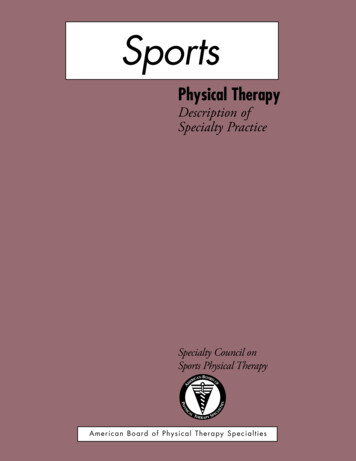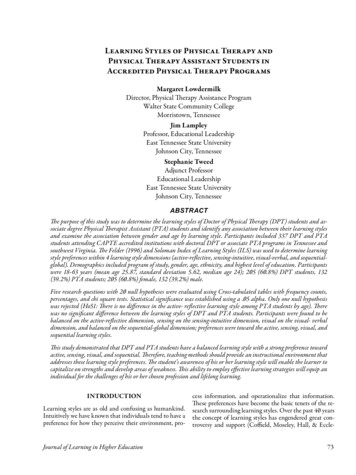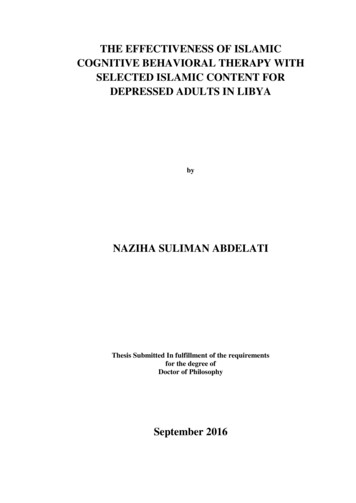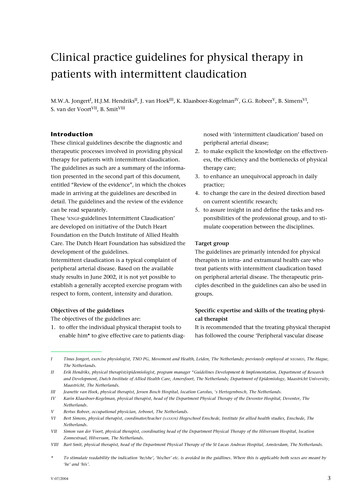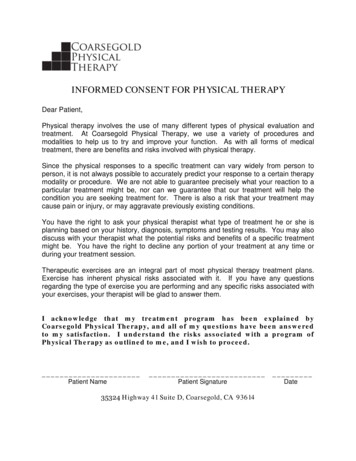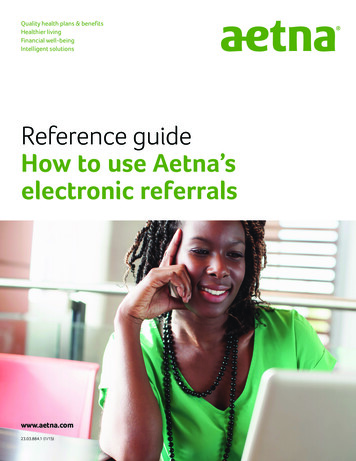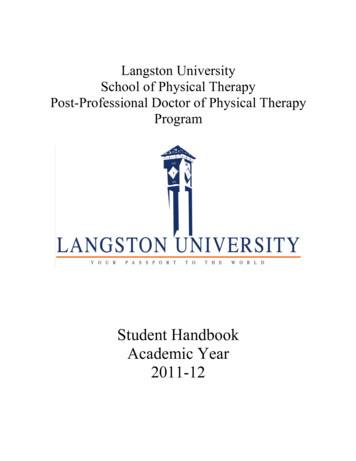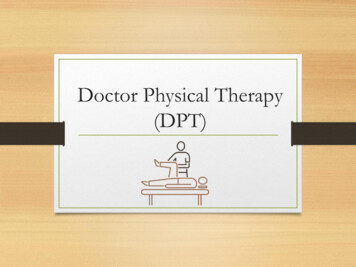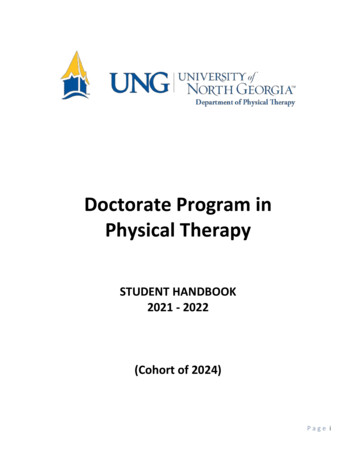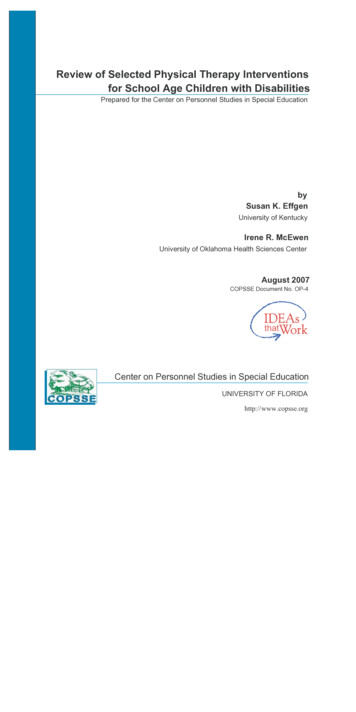
Transcription
Review of Selected Physical Therapy Interventionsfor School Age Children with DisabilitiesPrepared for the Center on Personnel Studies in Special EducationEXECUTIVE SUMMARYbySusan K. Effgen.Universityof KentuckyIrene R. McEwenUniversity of Oklahoma Health Sciences CenterAugust 2007COPSSE Document No. OP-4Center on Personnel Studies in Special EducationUNIVERSITY OF FLORIDAhttp://www.copsse.org
Center on Personnel Studies in Special EducationUniversity of FloridaJohns Hopkins UniversityVanderbilt UniversityUniversity of Colorado - BoulderInstructional Research Group, Long Beach, CACOPSSE research is focused on the preparation of special education professionals and itsimpact on beginning teacher quality and student outcomes. Our research is intended to informscholars and policymakers about advantages and disadvantages of preparation alternatives andthe effective use of public funds in addressing personnel shortages.In addition to our authors and reviewers, many individuals and organizations have contributedsubstantially to our efforts, including Drs. Erling Boe of the University of Pennsylvania andElaine Carlson of WESTAT. We also have benefited greatly from collaboration with the NationalClearinghouse for the Professions in Special Education, the Policymakers Partnership, and theirparent organizations, the Council for Exceptional Children and the National Association of StateDirectors of Special Education.The Center on Personnel Studies in Special Education, H325Q000002, is a cooperativeagreement between the University of Florida and the Office of Special Education Programs ofthe U. S. Department of Education. The contents of this document do not necessarily reflect theviews or policies of the Department of Education, nor does mention of other organizations implyendorsement by them.Recommended citation:Effgen, S. K. & McEwen, I. R. (2007). Review of selected physical therapy interventions for schoolage children with disabilities. (COPSSE Document Number OP-4). Gainesville, FL:University of Florida, Center on Personnel Studies in Special Education.GAdditional Copies may be obtained from:COPSSE ProjectP.O. Box 117050University of FloridaGainesville, FL 32611352-392-0701352-392-2655 (Fax)U. S. Office of SpecialEducation ProgramsThere are no copyright restrictions on this document; however,please credit the source and support of the federal funds whencopying all or part of this document.
CONTENTSIntroduction. . . . .4Methods. . . . . . . . . .7Results: Systematic Reviews of Intervention Procedures . .10Discussion. . . . . . . . .23Summary. . .26REFERENCES. . . . .28TABLESTable 1. Factors that Influence the Complexity, Frequency, and Durationof Physical Therapy Intervention and the Decision-Making Process . . . . .5Table 2. Search Terms Used . . .7Table 3. Levels of Evidence for Interventions and Grades ofRecommendations from Sackett . . .8Table 4. Levels of Evidence from the American Academy for Cerebral Palsyand Developmental Medicine . . . . . .9Table 5. Adapted Seating for Children with Cerebral Palsy . . . .10Table 6. Conductive Education . . . . .12Table 7. Constraint-Inducted Movement Therapy (CIT) . . .13Table 8. Lower Extremity Casting, Orthoses, and Splints for Childrenwith Neurological Disorders . . .14Table 9. Neurodevelopmental Treatment (NDT) . . .16Table 10. Partial Body Weight Supported Treadmill Training (PBWSTT) . . .17Table 11. Passive Stretching to Improve Range of Motion . .17Table 12. Strengthening . .19Table 13. Weight Bearing Interventions for Children with Cerebral Palsy. . .213
INTRODUCTIONPL 108-446, the Individuals with Disabilities Education Improvement Act of 2004 [IDEA](2004) requires special education and related services to be “based on peer-reviewed research tothe extent practicable.” (§300.320(a)(4)). This requirement, not included in previous versions ofthe law, is consistent with the current strong emphasis on evidence-based practice in physicaltherapy and the American Physical Therapy Association’s [APTA] Guide to Physical TherapistPractice, which provides a framework for describing and implementing physical therapy.However, much of the research on physical therapy interventions for children with disabilities isweak and conducted in non-educational environments.This paper reports on physical therapy procedural interventions with enough research availableto have been the topic of one or more systematic reviews. The interventions covered include:adapted seating for children with cerebral palsy [CP]; conductive education; constraint-inducedmovement therapy; lower extremity casting, orthoses, and splints for children with neurologicaldisorders; neurodevelopmental treatment; partial body weight supported treadmill training;passive stretching to improve range of motion [ROM]; strengthening for children with CP; andweight bearing interventions for children with CP. The paper also provides recommendationsfor application to physical therapy school-based practice and future research.Congress intended for PL 108-446 (IDEA, 2004) to help children with disabilities “achieve tohigh standards” – by promoting accountability for results, enhancing parental involvement, andusing proven practices and materials. Physical therapy as a related service supports a child’sacademic, developmental, and functional goals as determined by the child’s family, the child ifappropriate, and a team of professionals. The team outlines the child’s goals in an IndividualizedEducation Program [IEP], with the ultimate aim of preparing the student for further education,employment, and independent living (IDEA, 2004; 34 CFR §300.1). Local educational agencies[LEAs] must provide physical therapy when a student requires physical therapy to benefit fromspecial education.A widely disseminated definition of evidence-based practice is the “integration of best researchevidence with our clinical expertise and our patient’s unique values and circumstances" (Straus,Richardson, Glasziou, & Haynes, 2005, p. 1). This definition is more broad based andencompassing, not relying on peer-reviewed research alone. The best research evidence shouldbe valid and relevant. As new evidence becomes available, previously accepted evaluationmeasures and interventions must be replaced. Clinical expertise develops with advancing clinicalskills and experiences with children with disabilities. Parent and child values are the “uniquepreferences, concerns and expectations” (p. 1) that they bring to the situation. Physical therapistsmust integrate all these elements research, expertise, and family/child factors for evidencebased decision making.APTA’s Guide describes intervention as:the purposeful and skilled interaction of the physical therapist with the patient/client and,if appropriate, with other individuals involved in care of the patient/client, using variousPT methods and techniques to produce changes in the condition that are consistent withthe diagnosis and prognosis. (p. 43)4
Therapists make judgments regarding intervention based on evidence and the timely monitoringof the child’s responses and progress in achieving the anticipated goals. According to the Guide,intervention should include three important components: (a) coordination, communication, anddocumentation; (b) child/family-related instruction; and (c) procedural interventions.Table 1. Factors that Influence the Complexity, Frequency, and Duration ofPhysical Therapy Intervention and the Decision-Making Processaccessibility and availability of resourcesadherence to the intervention programanatomical and physiological changes related to growth and developmentcaregiver consistency or expertisechronicity or severity of the current conditioncognitive statuscomorbidities, complications, or secondary impairmentsconcurrent medical, surgical, and therapeutic interventionsdecline in functional independencelevel of physical functionliving environmentmultisite or multisystem involvementnutritional statusoverall health statuspremorbid conditionsprobability of prolonged impairment, functional limitations, or disabilitypsychosocial and socioeconomic factorspsychomotor abilitiessocial supportstability of condition(APTA, 2001, p.47)Coordination involves the organization and management of services with all parties workingtogether to ensure that the child and family “receive appropriate, comprehensive, efficient, andeffective quality of care” (APTA, 2001, p. 47) from initiation of services to the end of services.Coordination might involve arranging for equipment, assisting in eliminating architecturalbarriers, arranging with teachers for the best time and place to observe a child’s classroomperformance, and scheduling parent/teacher meetings. Communication includes written andverbal correspondence to convey information to the child, family, and other approved parties.Documentation is written information such as the evaluation report, progress notes and progressreporting, plan of care, summary letters to physicians, and information provided to Medicaid orother agencies that might pay for school-based services. Child and family-related instruction andinstruction for others who spend time with the child (such as physical therapy assistants,teachers, and aides) usually are important elements of physical therapy intervention for children.The family and teachers frequently are responsible for assisting the child to carry out or practicemany intervention activities. Proper instruction is necessary for the safety and protection of thechild and the service provider. Procedural interventions occur when the physical therapist“selects, applies, or modifies interventions based on examination data, the evaluation, thediagnosis and the prognosis, and the anticipated goals and expected outcomes" (APTA, 2001, p.47). Table 1 lists factors that the Guide describes as important in the decision-making process,including decisions about the type and intensity of intervention. Community support, family5
desires and degree of participation, LEA policies, the child’s desire to participate, and availableresearch evidence also influence decisions about goals and choice of interventions.This paper focuses on the peer-reviewed research on procedural interventions that physicaltherapists commonly use when working with children with disabilities (3-21 years) in schools.We report on interventions with enough research to have published systematic reviews, researchusing “explicit methods to systematically search, critically appraise, and synthesize the worldliterature on a specific issue. Its goal is to minimize both bias and random error” (Straus et al.,2005, pp. 147-148). Many common physical therapy interventions are not well researched; thus,published data is insufficient to support a systematic review. Systematic reviews, including metaanalyses that combine the results of studies quantitatively, are the most powerful and usefulevidence available to support interventions (Straus et al.). The purposes of this paper are toidentify: (a) effective physical therapy procedural interventions that lead to positive outcomes forchildren (3-21 years) with disabilities in schools; and (b) gaps in the evidence and areas requiringfurther research.6
METHODSCommon physical therapy interventions were identified by reviewing procedural interventions inthe Guide to Physical Therapist Practice (APTA, 2001), the Iowa AEA Physical TherapyConsensus on Peer-Reviewed Intervention II (2005), and pediatric physical therapy textbooks.Based on the review of those resources, we searched for systematic reviews related to thefollowing areas of procedural interventions: assistive technology; conductive education [CE];constraint-inducted movement therapy [CIT]; fitness, aerobic capacity, and endurance;function/goal-directed therapy; motor learning; neurodevelopmental treatment [NDT]; orthosesand casts; treadmill training; passive ROM and stretching; positioning; postural control; powermobility; strengthening; walking aids; and weight bearing. The databases searched included theCochrane Database of Systematic Reviews, CINAHL, ERIC, MEDLINE, PsycINFO, PEDro,and APTA’S Hooked on Evidence. The search terms used are listed in Table 2.Table 2. Search Terms Used (alone and/or in combination)aerobic capacityadaptationassistive technologybone densitycerebral palsychildconductive educationconstraint inducted movement therapycontracturedisabled childrenenduranceequipmentequipment designexercisefitnessfunction/goal directed therapyfunctionlocomotionmotor learningmotor skillsmovementneurodevelopmental treatmentorthosesorthotic devicesphysical therapypositionpositioningposturepostural controlpower mobilitypower wheelchairrange of motionresearchschoolseatingself-help matic reviewtreadmill trainingtreatment outcomewalking aidsweight bearingwheelchairWe included all the systematic reviews that met the following criteria: published in a peer-reviewed source focused on procedural physical therapy interventions with children aged 3-21 yearswith disabilities. The interventions could take place in any environment (limiting thereview to studies completed in schools would have severely restricted the researchavailable for review) published in English.7
Each of the identified systematic reviews used a grading system to evaluate the research. Manyguidelines and grading systems have evolved over the past few decades for use in systematicreviews of articles reporting intervention research. The most well-established system to gradethe quality of research is that of Sackett, Rosenberg, Gray, Hayes, and Richardson (1996) (seeTable 3).Table 3. Levels of Evidence for Interventions and Grades of Recommendationsfrom SackettLevel of Evidence(Sackett, 1989)Level I: Largerandomized trials withclear-cut results (andlow risk of error)Level II: Smallrandomized trial withuncertain results (andmoderate to high riskof error)Level III:Nonrandomized,contemporaneouscontrolsLevel IV:Nonrandomized,historical controlsLevel V: No controls,case-series only*pp. 173-177.Grade ofRecommendation(Sackett, 1989)Level of Evidence(Sackett et al.,2000)*Grade A1aGrade B1b2a2bGrade C3a3bType of Study(Sackett et al., 2000)*Systematic reviews of randomizedcontrolled trials (RCTs)Individual RCTs with narrowconfidence intervalSystematic reviews of cohortstudiesIndividual cohort studies and lowquality RCTsSystematic reviews of casecontrol studiesCase-control studiesGrade C4Case series and poor-qualitycohort and case-control studiesGrade C5Expert opinionThe scale has five levels, with Level I studies providing the strongest evidence based onrandomized controlled trials and Level V the weakest evidence case studies. The AmericanAcademy of Cerebral Palsy and Developmental Medicine [AACPDM] (2004) and Centre forEvidence Based Medicine [CEBM] (2001) have adopted similar scales for their systematicreviews. The AACPDM scale was one of the first to include a grading system for single-subjectdesign research (Butler & Darrah, 2001) (see Table 4).The PEDro Scale, developed by the Centre for Evidence-Based Physiotherapy [CEBP] (2007),uses 11 criteria to evaluate research. Some systematic review authors used the PEDro Scale toevaluate the research and another scale to grade the level of evidence.Each of the authors of this paper read and summarized the systematic reviews on approximatelyhalf of the procedural interventions. We agreed on the type of information to record for eachreview.8
Table 4. Levels of Evidence from the American Academy for Cerebral Palsy andDevelopmental MedicineLevelNon-empiricalIRandomizedcontrolled trialAll or none case seriesNon-randomizedcontrolled trialProspective cohortstudy with concurrentcontrol groupCase-control studyCohort study withhistorical controlgroupBefore and after caseseries without controlgroupIIIIIIVVGroup ResearchOutcomesResearchSingle subjectResearchN-of-1 randomizedcontrolled trialAnalytic surveyABABA designAlternatingtreatmentsMultiple baselinesacross participantsABA designAB designDescriptive caseseries/case reportsAnecdotesExpert opinionTheories based onphysiology, bench, oranimal researchCommon sense/firstprinciples(Butler & Darrah, 2001)9
RESULTS:SYSTEMATIC REVIEWS OF INTERVENTION PROCEDURESSystematic reviews of the following interventions used with school age children with disabilitieswere found: (a) adapted seating for children with CP; (b) conductive education [CE]; (c)constraint-induced movement therapy [CIT]; (d) lower extremity casting, orthoses, and splintsfor children with neurological disorders; (e) neurodevelopmental treatment [NDT]; (f) partialbody weight supported treadmill training [PBWSTT]; (g) passive stretching to improve ROM;(h) strengthening for children with CP; and (i) weight bearing interventions for children withCP. The results of these reviews are summarized below. Some research on the topics publishedsubsequent to the reviews also is included.Adapted Seating for Children with Cerebral PalsyPhysical therapists often recommend and/or provide adaptive seating for children with CP,muscular dystrophy, and other conditions involving the neuromuscular and musculoskeletalsystems.Table 5. Adapted Seating for Children with Cerebral PalsyAuthors(Date)TitleRoxborough(1995)Review of the efficacy and 8 studies(1982-1994)effectiveness of adaptiveseating for children with CPHarris &Roxborough(2005)Efficacy and effectivenessof PT in enhancing posturalcontrol in children with CP# Studies orReviews (YearRange)6 studies(1990-2004)Main ConclusionsEvidence supports effects of adaptiveseating on some functions of childrenwith CP, but stronger studies withfunctional outcome measures andstudies of specific features of adaptiveseating are needed.Common features of studies thatfound an effect of seating onchildren’s function were a slightlyanteriorly tilted seat and stable pelvis,and thighs supported in a flexed andabducted position.Proposed benefits of adaptive seating include improved postural control and alignment,improved hand and arm function, and prevention of deformities (McEwen & Hansen, 2006).Roxborough (1995) published a systematic review of research on the effects of adaptive seatingon children with CP, as shown in Table 5. Adaptive seating was defined as “the customprescription and application of sitting support devices based on therapeutic principles” (p. 17).The review included articles published between 1982 and 1994 meeting the following criteria:(a) participants included children with CP (birth–19 years); (b) adaptive seating was theindependent variable; and (c) the study included an unsupported sitting group or conditionwithout a comparison group. Each article was evaluated and the support for the intervention wasgraded according to the classification system (Sackett, 1989). The review included 8 studies. In4 studies dependent variables were measured after providing adaptive seating only briefly in acontrolled setting. In the other 4 studies children used adaptive seating for longer periods of10
time. One study was a single-subject design and the rest were group designs. Most of thestudies used different dependent variables.Three Grade A recommendations resulted from the systematic review, each from studies thatexamined the relatively immediate effects of adaptive seating in a controlled setting. Thesestudies found positive effects of adaptive seating: (a) pulmonary function (Nwaobi & Smith,1986); (b) active trunk extension (Miedaner, 1990); and (c) scores on the Bayley Mental Scale(Miedaner & Finuf, 1993). Grade B recommendations came from a thesis abstract (Gross, 1989)that reported no short-term effects of adaptive seating on reaching.The Grade Crecommendations were from the 4 studies with weaker designs that examined effects of adaptiveseating over longer periods of time. These studies showed adaptive seating to improve: (a) sittingposture (Hulme, Gallacher, Walsh, Niesen, & Waldron, 1987; (b) vocalization (Hulme, Bain,Hardin, McKinnon, & Waldron, 1989; and (c) oral motor eating skills (Hulme, Shaver, Archer,Mullette, & Eggert, 1987). The studies did not show an effect of adaptive seating on: (a) visualtracking (Hulme, Gallacher et al., 1987); (b) self-feeding (Hulme, Shaver, et al., 1987); and (c)drinking skills (Hulme, Shaver, et al., 1987). Roxborough (1995) concluded that studies withstronger designs and valid outcome measures are necessary for definitive answers about theeffects of adaptive seating compared with unsupported sitting and to determine the specificfeatures of adaptive seating required to achieve the desired outcomes.In 2005 Harris and Roxborough published a systematic review to update and expandRoxborough’s 1995 review. Studies of interventions for children with CP that were designed toimprove postural control, identifying 6 studies that examined adaptive seating, were reviewed.They rated the studies as strong, moderate, or weak, and classified each according an earlyversion of the AACPDM Quality Assessment Scale (2004).Recommendations were not graded as Roxborough (1995) did in the first systematic review;however, no Grade A recommendations would have been given using the same criteria. A gradeB recommendation could be made for an effect of adaptive seating on postural control based onthe 2 Level II studies (Reid, 1996; Washington, Dietz, White, & Schwartz, 2002). Five studiesfound improved postural control during short-duration interventions (Myhr & Von Wendt, 1991;Reid, 1996); intervention of moderate duration (Washington et al.); and at follow-ups of 3 years(Pope, Bowes, & Booth, 1994) and 5 years (Myhr, von Wendt, Norrlin, & Radell, 1995) followup. Common features of the adaptive seating in these studies were a slightly anteriorly tilted andstabilized pelvis and support of the thighs in a flexed and abducted position. Harris andRoxborough (2005) concluded that future studies of adaptive seating should not study posturalcontrol in isolation, but should examine the effects of adaptive seating on functional abilities andon the development of independent sitting.The studies reviewed in Roxborough (1995) and Harris and Roxborough (2005) used a variety ofseating devices and adaptations. Many reports, particularly the earlier ones, did not describe thedevices and adaptations well enough for later researchers to replicate the equipment or replicatethe process for making decisions about the type of seat and needed adaptations.In summary, research indicates that adaptive seating can affect a child’s function and posturalcontrol. A stable pelvis probably is important; and seating orientation is likely to make adifference for at least some children during certain tasks. This conclusion is consistent with a11
review of evidence of effects of positioning on upper extremity function in children with CP(Stavness, 2006). The reviewed evidence supports an orientation in space of 0 to 15 degrees anda seat sloped forward 0 to 15 degrees, with the exact angle needing to be determined on anindividual basis. Physical therapists should systematically evaluate children’s functioning invarious positions in various positions and with adapted seating having various features todetermine optimal positions for children who lack good postural control.Conductive Education (CE)CE is a holistic approach to the development and education of children with neurologicaldysfunction, predominantly CP. Individuals trained to provide this intervention are calledconductors. Although conductors are available in many parts of the world, an increasing trend,including in the U.S., is for physical therapists to provide the integrated gross motor portion ofthis curriculum. Parents frequently request this intervention for their children in school settings(Feinberg, Beyer, & Moses, 2002).CE is not a therapy system but a system of education that aims to teach and motivate the child tofunction in society. Emphasis is placed on motivation, developing self-esteem, emotional andcognitive growth, and motor function. This school-based comprehensive program has gainedpopularity around the world, and a number of studies have been done in England and Australia.See the findings in Table 6.Table 6. Conductive EducationAuthors(Date)Title# Studies orReviews (YearRange)Main ConclusionsDarrah,Watkins,Chen, &Bonin (2004)Effects of ConductiveEducation intervention forchildren with a diagnosis ofCP: An AACPDMEvidence Report15 studies(1972-2000)The present literature base does notprovide conclusive evidence either insupport of or against CE as anintervention strategy. The limitednumber of studies and their weakquality makes it impossible for theliterature alone to guide decisionmaking regarding CE.A systematic review by Darrah, Watkins, Chen, and Bonin (2004) of 15 articles publishedbetween 1966 and 2001 found only 1 study with the highest level of evidence; 9 of the 15 studieswere classified as Level III or IV. Most studies received weak ratings for control of threats tointernal validity. These authors concluded that: “The present literature base does not provideconclusive evidence either in support of or against CE as an intervention strategy. The limitednumber of studies and their weak quality makes it impossible for the literature alone to guidedecision-making regarding CE” (p. 202). The Darrah et al. review and a review by the AlbertaHeritage Foundation for Medical Research (Ludwig , Leggett, & Harstall, 2000) suggest that CEis no more effective than “traditional educational and therapeutic intervention” and “there is nogood scientific evidence to support the use of CE in place of other treatment programs forchildren with cerebral palsy” (p. ii). A study by Stiller, Marcoux, and Olson (2003), publishedafter the systematic review, investigated the effects of intensive therapy (1 hour of individual12
physical therapy, occupational therapy, speech therapy and group therapy per day), CE (6hours/day), and special education (6 hours/day with therapy provided as indicated in the child’sIEP) on the function of 19 children with CP. After a program of 5 days/week for 5 weeks, therewere no statistical differences between groups; however, further analyses indicated statisticallysignificant changes for the intensive therapy group on the Pediatric Evaluation of DisabilityInventory (PEDI) self-care and social function scales and on the crawling and kneeling scales ofthe Gross Motor Function Measure (GMFM). The secondary findings of this non-randomizedcontrolled trial study suggest that intensive therapy may be more effective for children with CPthan CE or special education services; however, further investigation is clearly required.In summary, the systematic reviews indicated that CE is as effective as traditional physicaltherapy when intensity of intervention is controlled. In general practice not involving research,CE has a higher level of intensity of intervention than traditional therapy. The lack of significantbenefits of CE over traditional physical therapy when intensity is controlled for, coupled with thefindings of Stiller et al. (2003), which suggest that intensive therapy is more effective forchildren with CP than CE or special education services, raises concerns about this intervention.Further investigation is clearly warranted.Constraint-Induced Movement Therapy (CIT)CIT, previously referred to as forced use therapy, is a relatively new procedural intervention usedby physical therapists. The protocols were first developed for adults who had had a stroke. Theprotocol involves the forced use of the impaired upper extremity while the other (non- impaired)extremity is constrained for most waking hours by a sling, mitt, or cast. See Table 7.Table 7. Constraint Inducted Movement Therapy (CIT)Authors(Date)Title# Studies orReviews (YearRange)Main ConclusionsCharles &Gordon (2005)A critical review ofconstraint-inducedmovement therapy andforced use in children withhemiplegia.15 studies(1990-2005)Studies suggest that CIT is apromising intervention for improvinghand function in children withhemplegia. However the data arelimited and much more work must bedone before this approach should beconsidered for general use in theclinic.Many research studies have indicated the effectiveness of this intervention with adults poststroke in improving upper extremity function (Levine & Page, 2004). Because of the success ofCIT with adults, research has been undertaken in children with hemiplegic CP. A critical reviewby Charles and Gordon (2005) suggests that CIT appears to be a promising intervention forimproving hand function in children with hemiplegia although “substantially more work must beperformed before this approach can be advocated for general clinical use” (p. 245). Morerecently, a randomized crossover trial of CIT included 18 children with hemiplegia (Deluca,Echols, Law & Ramey, 2006). In the study, CIT produced significantly greater gains as13
measured on the Quality of Upper Extremity Skills Test and the Pediatric Motor Activity Logthan conventional physical therapy and occupational therapy.Several less intrusive protocols have been studied with the children with shorter wearing timesof the splint or cast than used in CIT for adults (e.g., Charles & Gordon, 2006). No one protocolhas been determined to be the most effective.In summary, the CIT shows promise as an intervention for children with hemiplegic CP. CIT hasnot been studied directly in a school setting; however, it has been investigated with success in aday ca
therapy and the American Physical Therapy Association's [APTA] Guide to Physical Therapist Practice, which provides a framework for describing and implementing physical therapy. However, much of the research on physical therapy interventions for children with disabilities is weak and conducted in non-educational environments.
